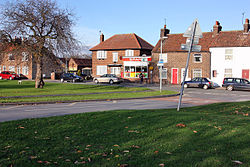Hutton Cranswick
| Hutton Cranswick | |
| Yorkshire East Riding | |
|---|---|
 Hutton Cranswick village Post Office | |
| Location | |
| Grid reference: | TA023525 |
| Location: | 53°57’31"N, 0°26’32"W |
| Data | |
| Population: | 2,065 (2011) |
| Post town: | Driffield |
| Postcode: | YO25 |
| Dialling code: | 01377 |
| Local Government | |
| Council: | East Riding of Yorkshire |
| Parliamentary constituency: |
East Yorkshire |
Hutton Cranswick is a village in the East Riding of Yorkshire, about three miles south of Driffield town centre, and on the A164 road.
Originally comprising two villages, Hutton to the north, and Cranswick to the south, the expansion of the villages has merged them together to form a single village, 'Hutton Cranswick'. However, the individual parts of the village are still often referred to by their separate names and both maintain their individual character.
The wider civil parish includes Hutton Cranswick itself and two hamlets, Rotsea and Sunderlandwick. The 2011 census recorded a parish population of 2,065.
History
Hutton and Cranswick are each listed in the Domesday Book.
Within the village is the remnant of a 13th-century monastic moat beside Sheepman Lane, marking the site of a former Cistercian Grange belonging to Meaux Abbey near Beverley.
Less than a mile north-west of Hutton are the remnants of Howe Hill Bronze Age round barrow. The mound is 75 feet in diameter, and was excavated in 1892. Flint articles were found, and evidence of previous disturbance of the site, including burnt bones and a food vessel indicating a burial site. The mound later might have been used as a moot hill local meeting place. At the same site, to the north-west of Old Sunderlandwick Lane, is earthwork evidence of the deserted mediæval village of Sunderlandwick—a settlement mentioned in the Domesday Book, with enclosures, hollow ways, ridges and furrows, and ditches.[1]
A record of Hutton Cranswick in 1823 notes that the parish church was under the patronage of Lord Hotham. There existed a Methodist chapel and a Sunday school. Population at the time was 917. Occupations included 19 farmers, two blacksmiths, two wheelwrights, two joiners, three shoemakers, four shopkeepers, three tailors, a rope maker, a butcher, a corn miller, and the landlords of The Pack Horse and the Decoy Inn public houses. Two carriers operated between the village and Hull, Beverley, and Driffield once a week.[2]
The village railway station opened in 1846, as part of the Scarborough Branch Railway.[3]
Under a mile south-west of Cranswick is the site of the Second World War military airfield RAF Hutton Cranswick, operational between 1942 and 1946. Aerial photographs show indications of landing strips and hangars.[4]
Parish church
The parish church, St Peter's, is a Grade II* listed building.[5]
About the village
Cranswick local shops, a farm shop run by a local farming family, and a butchers. There is a public house, a garden centre, a hairdresser, a fish and chip shop and garages selling both cars and petrol. At the south-west of the village is an industrial estate with businesses including Cranswick Mill.
The large village green contains a pond, play-park area and mature trees. "Swinekeld Pit" (pronounced "Swinkle"), with a small stream, lies at the bottom of Southgate in Cranswick.
The village has a small railway station, served by Northern services on the Yorkshire Coast Line.
Outside links
| ("Wikimedia Commons" has material about Hutton Cranswick) |
- Hutton Cranswick village
- Hutton Cranswick in the Domesday Book
- Hutton Cranswick in the Domesday Book
References
- ↑ National Monuments Record: No. 79336 – Sunderlandwick
- ↑ Baines, Edward (1823). History, Directory and Gazetteer of the County of York. p. 358.
- ↑ National Monuments Record: No. 497781 – Hutton Cranswick Station
- ↑ National Monuments Record: No. 1398738 – Hutton Cranswick Airfield
- ↑ National Heritage List 1161006: Church of St Peter (Grade II* listing)
- 'A Tale of Two Villages, Hutton and Cranswick' (1980)
- Gazetteer — A–Z of Towns Villages and Hamlets. East Riding of Yorkshire Council. 2006. pp. 4, 7.
